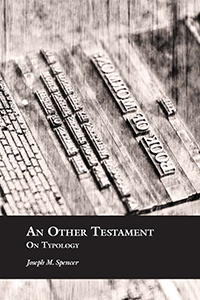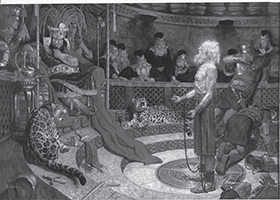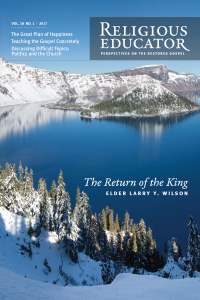Review of An Other Testament: On Typology
Andrew C. Skinner
Andrew C. Smith, "Review of An Other Testament: On Typology," Religious Educator 18, no. 1 (2017): 130–7
Andrew C. Smith (andrew.smith.3223@gmail.com) was an adjunct instructor of Religious Education at BYU when this article was published.
 Joseph M. Spencer. An Other Testament: On Typology. Provo, UT: Neal A. Maxwell.Institute for Religious Scholarship, 2016. 194 pp., with index. ISBN-13: 978-0983963622. US $15.95.
Joseph M. Spencer. An Other Testament: On Typology. Provo, UT: Neal A. Maxwell.Institute for Religious Scholarship, 2016. 194 pp., with index. ISBN-13: 978-0983963622. US $15.95.
Typology has held a place of importance in the Christian tradition as a method of theology, scriptural exegesis, and history from the composition of the New Testament onward. In An Other Testament: On Typology, Joseph Spencer examines the place of typology within the Book of Mormon in order to understand the book’s theological complexity: “By theological complexity, I do not primarily mean that the ideas presented in the Book of Mormon are complex, though sometimes they are. Rather, I mean that it can be difficult to bring into focus some of the Book of Mormon’s overarching theological claims, given the book’s structural complexity” (xi; emphasis in original). In order to bring these theological claims into focus, Spencer embarks on a close and detailed reading of the structures and underlying theological viewpoints within the writings of Book of Mormon figures.
While not looking to establish a systematic theology based in the Book of Mormon, Spencer, according to his updated preface for the new edition, is intent on practicing a scriptural theology, refusing “to be satisfied with either the strictly referential meaning or even the more robust communicative sense of scripture. The scriptural theologian is convinced that the text has not been exhausted until its relevance to life has been investigated. And the good scriptural theologian is convinced that that investigation is infinite, that the text will never have been exhausted” (preface to the second edition). The result is a slim but dense book, filled with incredible insight into the points of view and methods of reading scriptural history employed within the Book of Mormon. For those willing to put in the intense effort required to get through his dense prose and theological wrestling, Spencer’s An Other Testament will reward them with a deeper understanding of how the Book of Mormon presents itself—“how the Book of Mormon teaches us to read the Book of Mormon” (xi)—and will ultimately change the way they look at the book. This is particularly true as it relates to the detailed structural analysis that Spencer undertakes as the foundation for his theological work.
An Other Testament begins with Spencer outlining his method and approach to the Book of Mormon as well as how he has structured the analysis. Here, Spencer notes that the Book of Mormon’s complexity is reinforced by readers lacking understanding of its structural arrangement (or not paying enough attention to how the book and its messages are arranged and presented) as well as the problem of having those ideas firmly embedded and presented from within historically complex circumstances. Spencer addresses this latter point—that of historicity—in his last point of the preface with an acknowledgement of his position and active “faith commitments,” leading him to “consistently assume the historicity of the Book of Mormon throughout the book” (xiv). However, he hopes that more secularly-focused “scholars of Mormonism generally have something to learn from a believing Mormon theologian hard at work on scripture” (xiv, emphasis in original).
The body of the book consists of five chapters, with an epilogue acting as an overall conclusion. The first chapter is devoted to an extended analysis of Alma 36 and the way Alma the Younger presents his conversion experience typologically or as intertwined with a reading of a former prophet’s experience (that of Lehi in 1 Nephi 1). Analyzing how Alma views and utilizes typology in the pursuit of knowledge and conversion, Spencer uses this chapter as a springboard to approach how typology is utilized elsewhere, devoting the last four chapters to “examining the textual structures and historical entanglements that contextualize and complicate what Nephi and Abinadi have to say about typology” (xii). Yet he recognizes that the methods of typology are not uniform in the Book of Mormon. Nephi and Abinadi, while both developing their ideas about typology and “likening” in discussion of the words of Isaiah, come to distinctly different notions of what typology is and how it should be utilized in the application and interpretation of the Law of Moses and the reading of the Prophets. Spencer states:
The difference between Nephi and Abinadi is embodied in the words themselves. While Abinadi speaks explicitly of ‘types’ (a plural noun), Nephi speaks of ‘typifying’ (a gerund). Whereas Abinadi understands the individual laws, performances, and ordinances of the Law to be individually typical of the various individual events of Christ’s mortal ministry, Nephi focuses primarily on the whole Law as indicative of Christ’s coming. In short: Abinadi’s Law of Moses was called for because of the atonement still to come; Nephi’s Law of Moses calls for the atonement to come. (161; emphasis in original)
In addition, he stresses that Nephi sees the process of typology as being engaged on a covenantal, communal, and eschatological level, while Abinadi focuses more on an individual and soteriological level associated with the mortal ministry of the Messiah. Nephi’s method leads to a grand, sweeping understanding of scriptural history on a larger scale, while Abinadi’s approach focuses on specific events and their typological meaning.
These differences play out not just in the methods of utilizing scripture but also with regard to aspects of Nephite community governance and religious doctrine, particularly with ideas about the Godhead and baptism in the Book of Mormon. Spencer hypothesizes that “there had been in the Nephite ecclesiastical tradition a ‘Nephi faction’ and an ‘Abinadi faction’” (107). This rift is only ultimately resolved or healed when Christ teaches the Nephites to overcome the “disputations” that have existed within the community by reasserting Nephi’s view over that of Abinadi.
Spencer ultimately notes that while these two methods of reading scripture are somewhat at odds one with another, and though Jesus emphasizes Nephi’s view in his discourses, Spencer does not mean to portray Abinadi’s typological understanding as worthless. Rather, he sees the Book of Mormon as presenting Abinadi’s views as akin to a “lower” approach, while the “higher” approach is Nephi’s typology. This is an important point, especially when one considers (as Spencer does) that the majority of LDS readings of the Book of Mormon follow Abinadi’s approach: “the common approach is to read Book of Mormon narratives and prophetic sermons as so many dissociated pieces, all of which can be taken as types of one’s personal experience with the Savior” (173–74). Yet there is the danger in reading this way: “All too often, Abinadite readings risk disintegrating into just so many individualistic and ultimately idiosyncratic devotional reveries” (174). Thus, Spencer’s whole enterprise is to promote, in addition to the standard Abinadite or lower approach to reading, a higher model open to seeing and reading the Book of Mormon “not only as a gathering of texts about the covenant, but as a singular text intertwined, in its very material existence, with the actual fulfillment of the covenant,” reading it “by an interpretive method that recognizes not only the importance of one’s personal daily engagement with Christ, but also the vital importance of giving oneself to the communal, covenantal event launched, according to the Book of Mormon, by the Book of Mormon itself” (175).
This overarching theological enterprise is supported by a vast number of important and vital insights with regard to the text of the Book of Mormon. Spencer shows a brilliant ability to tease out difficult structural elements that play an important role in the presentation of the Book of Mormon’s messages: the structural discussion of Alma 36 and its relationship with 1 Nephi 1, building on the works of John Welch and George Tate (1–11); the general analysis of the structure of Nephi’s writings (chapter 2); the overall structure of the Book of Mosiah (114–20); and the larger structure of Mormon’s greater literary project (106–14). Similarly, his expositions of certain difficult passages—such as the paradox of Alma’s conversion (11–16), Nephi’s slaying of Laban (84–93), and the motivations of Noah’s priests and Abinadi’s response to their challenge to interpret Isaiah (142–64)—provide not only the support structure for the argument Spencer is making, but are also each considerable additions in the field of Book of Mormon studies in and of themselves. They all enhance the field, expanding upon the works of exegesis and interpretation that have come before. Additionally, they also set an incredibly high bar for future scholarly and devotional works on the nature, message, and intent of the Book of Mormon, whether from more secular, academic views or more conservative, traditional Mormon approaches.
With that being said, however, the book is not perfect (as Spencer notes in his updated preface). Spencer never discusses or fully defines typology as such, which may be problematic both from a scholarly perspective and for readers who don’t have a strong understanding of Christian exegetical and hermeneutic methods.[1] Even a few paragraphs about such would have laid a stronger foundation for his discussions. Additionally, the prose is dense and in some instances exceedingly technical or overly philosophical or theological, especially where Spencer uses terms specific to his own developed theories (such as “evental”) or engages in philosophical exegesis that is not as clear as other portions of the book—for instance, his discussions of Alma’s epistemology, with its complications and interactions of “thought” and “memory” (13–24). While this may be a turnoff for less-scholarly readers, the fact that understanding requires work and mental exertion makes its reward that much sweeter. As a word of advice, it will probably be best for many readers to study this with an open copy of the Book of Mormon at hand, as many times Spencer refers to multiple scriptural passages and specifics assuming a distinct familiarity with content based on simple citations.
 Abinadi standing before King Noah.
Abinadi standing before King Noah.
Likewise, there are some points or contentions about which I am not fully convinced by Spencer’s arguments. For example, Spencer declares repeatedly that the Book of Mormon itself teaches us to read it typologically.[2] While I would not dispute that this is one way the Book of Mormon authors present their writings, it does not seem particularly self-evident that the ways individual prophets read the works of their predecessors, none of whom had access to a completed Book of Mormon, should dictate one specific manner in which we should read the whole of the Book of Mormon. To illustrate by comparison, the way Paul in the New Testament reads Old Testament passages, while being insightful, does not in any way determine a single method in which the Old Testament should be read by others, even believing Christians. Likewise, within the Book of Mormon, there are authors and writers (other than Nephi, Abinadi, and Alma) who utilize other methods for reading and interpreting scripture. Grant Hardy, in his volume Understanding the Book of Mormon, points out the vastly different methods of Mormon and Moroni in reading and editing the scriptures and historical narratives they included.[3] Their methods are distinctly opposed to one another in certain ways, yet each could also constitute a way that the Book of Mormon instructs us on how to read the Book of Mormon. Just as Spencer is clear to point out that Abinadi’s reading of scripture should not be jettisoned wholly for Nephi’s reading, all other ways of reading the Book of Mormon should not be jettisoned in favor of a typological reading. Rather, holding the readings in a creative tension, or accepting a multivalent perspective on the various ways and means the Book of Mormon teaches us how to read the Book of Mormon, would not only be valuable, but may stop our intellectual pendulums from getting stuck in interpretive extremes.
All that being said, I would readily recommend this book to any and all who desire greater insight into the Book of Mormon as a scriptural text, especially as a method for gaining insight into one method of reading that is not generally practiced in LDS approaches to the Book of Mormon. It is particularly an important volume for the consideration of those called upon to teach this text, as it emphasizes the complexity and importance of continually coming to the text with eyes open for greater understanding. We must always be open to viewing with new eyes and hearing with new ears. As Nephi exhorts us, “Wo be unto him that saith: We have received, and we need no more!” (2 Nephi 28:27).
Notes
[1] The closest stated definition of typology comes within the context of overviewing Alma’s ideas of typology: “As Alma develops it, typology is a question of how events—singular, unpredictable experiences with the divine—interrupt the natural flow of history and so allow for the past to be understood in new, redemptive ways. Put in Alma’s own words, typology is a question of allowing new thought to rework memory, so that it becomes possible to advance in the knowledge of God” (xii). But this does not speak to a greater definition of typology, and, even more, it is qualified by statements that Nephi and Abinadi develop typology differently.
[2] While Spencer does not make the claim specifically that a typological reading is the sole authentic reading, his repeated declarations that this is how the Book of Mormon should be read or teaches us to read itself may come off as somewhat prescriptive in that regard.
[3] See Grant Hardy, Understanding the Book of Mormon: A Reader’s Guide (New York: Oxford University Press, 2010), 91, 119, 222–25, 235, 240.
